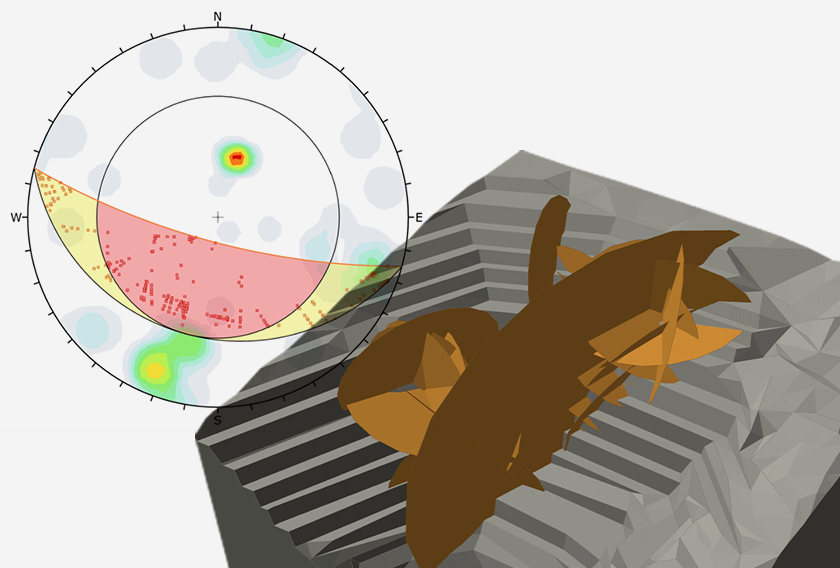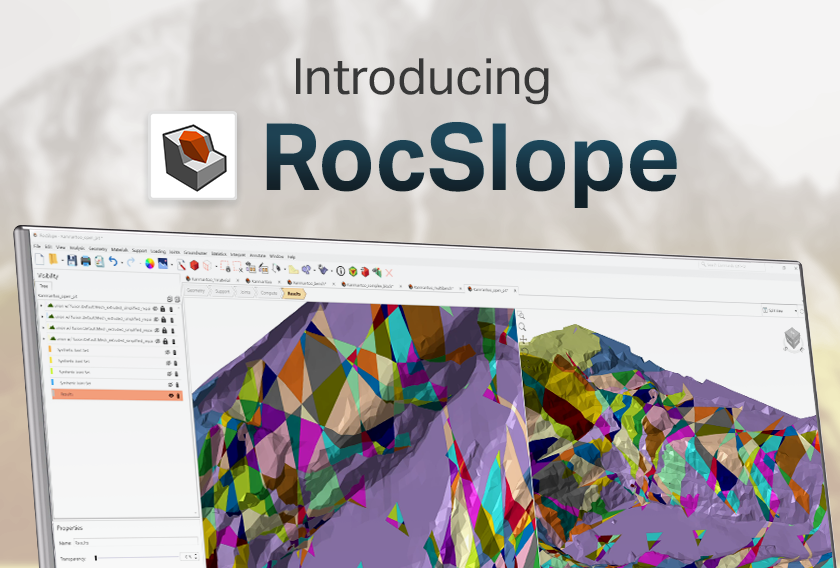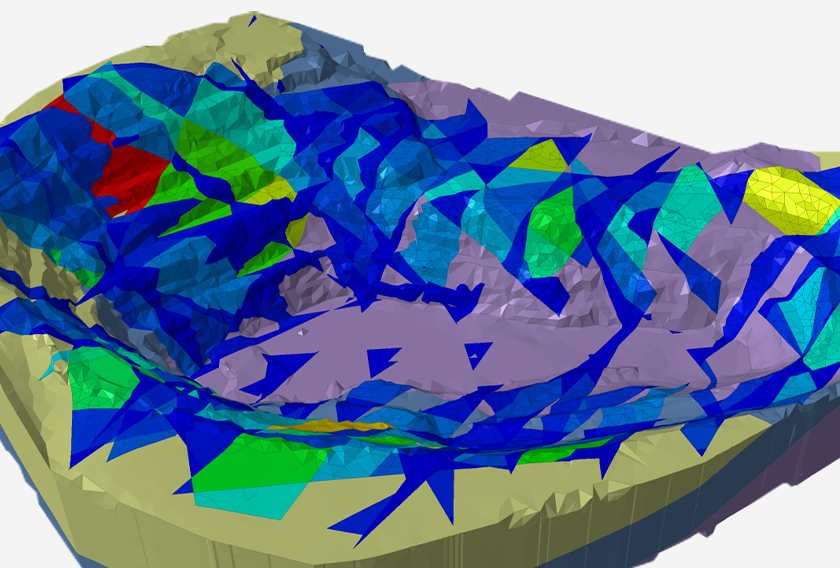The Guide to RocSlope3: Q&A's
It's an exciting time if you're a practitioner dealing with rock slope stability problems. RocSlope3, our brand-new 3D product, designed to assess the factors of safety of blocks in highly jointed rock masses, provides critical insights into the magnitudes and likelihood of translational block failures over each region of a slope.
With a software suite of 19 products, we have many programs with similar capabilities, however each program is optimized for specific problems. The guide below will answer common questions that you may have about how and when to use RocSlope3.
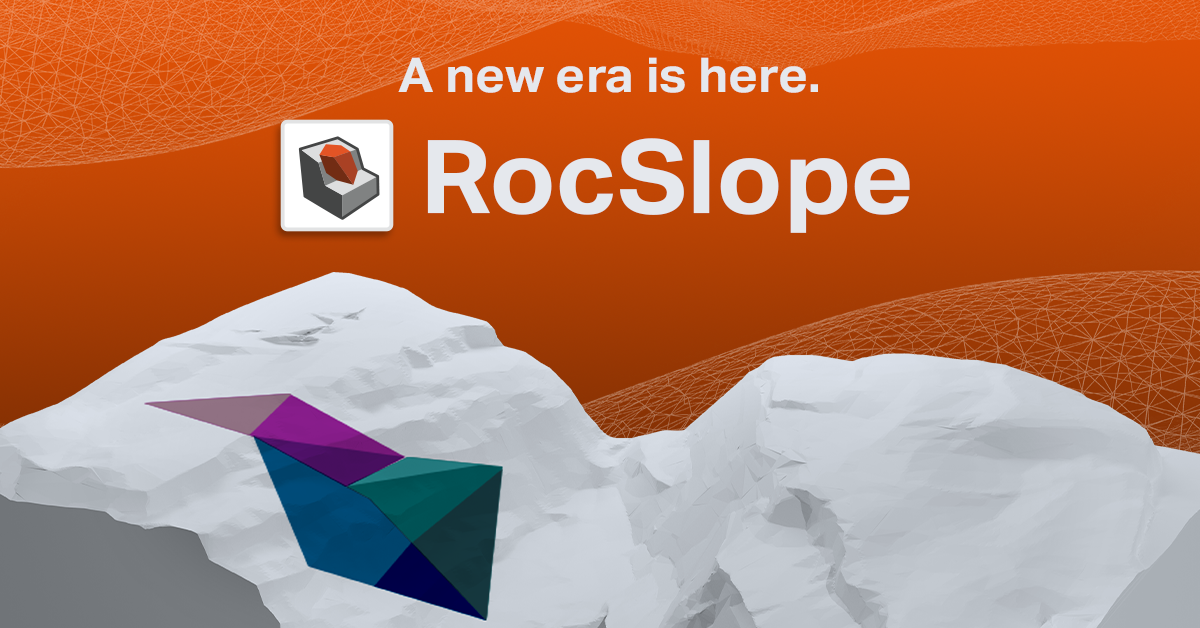
Where can RocSlope3 be used?
- Mining (entire open pit or sector of the pit): RocSlope3 can assess and locate large and small-scale failures across the benches of an open pit as part of optimal pit design, safety planning and risk mitigation during the design and operational stages.
- Civil: RocSlope3 is perfect for geological hazard assessment of the stability of rock slopes adjacent to or overlying civil infrastructure such as roads, highways, railways, and bridges. You can also apply slope stabilization measures by modeling the effects of rock reinforcements and drainage.
What does structurally controlled mean?
RocSlope3 is designed for 3D block stability analysis in rock slopes susceptible to structurally controlled failures.
- Hard rock with discontinuities, where the failure surfaces are along the discontinuities, and failure is controlled by the shear strength of the sliding joints
- Blocks are formed by the intersection of geological features such as faults, joints, bedding planes, and foliations; they must form water-tight volumes
Does rock mass strength play a role in the analysis?
Currently, only discrete blocks formed by joints which persist and intersect are considered as potential failure masses. Rock bridging and failure through intact rock mass is not considered. Therefore, rock mass strength is not an input in RocSlope3. In a future iteration of RocSlope3, we will be looking at:
- Rock mass bridging: The failure propagates from the joint surface and through the intact rock mass. Both the strength of the weaker sliding joint and the portion of intact rock mass must be overcome for failure to occur.
- Persistence sensitivity: Intersection and ultimately the formation of discrete blocks is sensitive to the persistence of joint surfaces. Therefore, it is important to analyze the impact of scaling discrete joint surfaces.
Are the algorithm searches for pyramid wedges isolated by a maximum of three joint sets (similar to UnWedge)? Additionally, does the algorithm also include a search for composite blocks?
In RocSlope3, we call them “blocks” as they can have any arbitrary number of joint faces and can be quite complex in geometry (not limited to wedges, tetrahedral pyramids).
The blocks are determined by the intersection of joint surfaces, and they must fully persist to create a closed volume to be deemed a valid block. Currently, we do not support the search for composite blocks, as the logic is very complex to determine a unique coupling of blocks which would create a larger block volume which is still removable. Instead, we employ an adjacency algorithm to determine successive failure of neighboring blocks (i.e., What would happen if a key block were to be removed? Would a neighboring block that would otherwise be stable, now become unstable?). We iteratively compute this global slope failure until all remaining blocks are stable.
How is RocSlope3 different than SWedge?
RocSlope3 is not meant to replace SWedge but rather bridge the gap which exists between SWedge and industry needs. They apply to different applications in rock slope analysis:
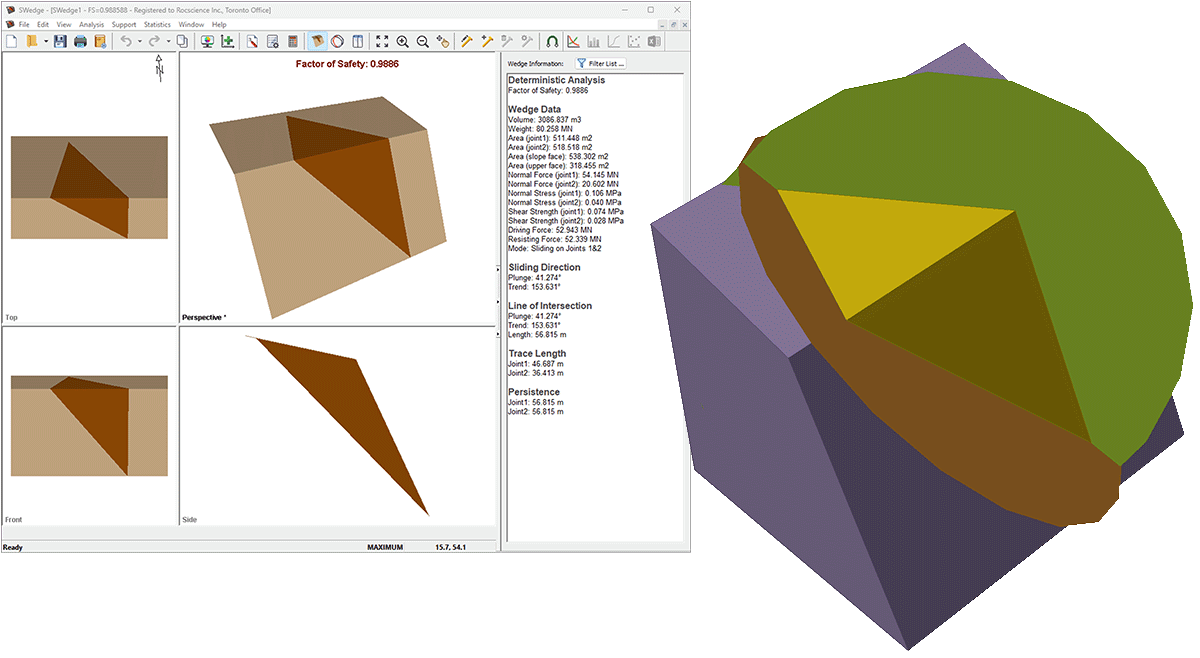
Criteria |
SWedge |
RocSlope3 |
Scale of analysis (and slope geometry) |
Bench-scale (or simple slope cuts) consisting of an upper face (in mining, this would be the bench) and a slope face (in mining, this would be the bench face). Optimize bench width and bench face angle, considering the spill width and back break distances. |
Full-scale consisting of geometries for entire open pits and large slope extents. Determine if failures are at the interramp scale (spanning multiple benches) or at the crest (bench-scale).
|
Joints |
Planar surfaces with orientation and are modeled as ubiquitous (occur everywhere) and infinite; this is a common assumption because it’s hard to obtain information about location and extents of discontinuities and it’s a conservative approach to ensure that the largest wedge is formed on the slope. |
Planar surfaces with orientation and are modeled as discrete with defined location, shape, and persistence. Various methods are available:
Blocks can only form where joints exist, daylight, and persist enough to intersect. |
Block shape |
Tetrahedral wedges formed by two joints; or pentahedral wedges formed by two joints and a basal failure plane. An optional tension crack can also be modeled. |
Arbitrary block formed by any number of intersecting joint planes. Can be planar, wedge, complex concave/convex blocks. |
Number of blocks |
Single wedge analysis |
Hundreds to thousands of blocks |
Materials |
Single material (i.e., single rock unit weight) |
Multiple materials (i.e., multiple rock unit weights) |
Water pressure |
Simple water pressure models and ponded water. |
Various groundwater methods (e.g., water surface, water pressure grid, ru coefficient, constant pressure) and ponded water. |
Location |
Factor of Safety or Probability of Failure for a single wedge; no information about location |
Heat map showing the magnitudes and locations of:
Location is very important in hazard mapping, risk assessment and mitigation because we need to know where failure is most likely, the scale of the failure, and support requirements in those locations |
Specialized analysis |
|
|
How is RocSlope3 different than Slide3 and RS3?

RocSlope3 was designed to specifically deal with structurally controlled failure. While RS3 can also model joints, it is far more complex to create the model. Slide3, although it can handle weak layers and anisotropy, it is not ideal for handling rigid body sliding in the case of block sliding.
Criteria |
Slide3 |
RS3 |
RocSlope3 |
Analysis type |
Limit Equilibrium Method
|
Finite Element Method
|
Limit Equilibrium Method
|
Failure surface |
Critical failure surface (any shape) obtained through LEM of columns. |
Region of highest stress and displacement (any shape) obtained through FEM shear strength reduction. |
Strictly structurally controlled (planar, wedge, block) formed by intersection of joints. |
Failure mechanism |
Failure through rock mass |
Composite failure through a combination of joints and rock mass |
Strictly structurally controlled failure through joints |
Specialized analysis |
|
|
|
How does RocSlope3 fit within our product line?
- RocSlope3 is not a replacement for SWedge. There is a time and place for both. SWedge allows you to focus on local failure while RocSlope3 provides the full picture of the entire mine or slope surface. Should you find a local failure at the bench-level, SWedge is a great program for analysis. When you’re looking at back analysis or even preliminary analysis, SWedge is optimal as it is much quicker.
- RocSlope3 can be great in conjunction with Slide3. Depending on the quality of the rock, you may wish to see if the joints have potential to fail or if the rock mass itself could fail. Together, these two products provide a very comprehensive toolkit for risk assessment, no matter what type of conditions your project has. You also have the benefit of using the same geometry in both programs, so you can get a complete picture of your slope’s stability efficiently.
- If you have the latest version of Dips, you’ll be able to utilize the integration with RocSlope3 so you can directly import data from Dips into RocSlope3 and use that to compute the blocks. This integration will be a huge time saver!
- For users of Slide3, or RS3, or RocFall3, there is very little learning curve as RocSlope3 has a consistent user interface as our other 3D tools. Plus, you have the ability to use the same geometry in RocSlope3, Slide3, and RS3.
Will there be an underground version of RocSlope3 in the future?
We are currently developing an underground version of RocSlope3. Stay tuned to our social media channels for updates on the release.
What license types are available for RocSlope3?
RocSlope3 is currently available as a Personal or Flexible Lease. For more information about RocSlope3 license type's, visit the plans and pricing page.
